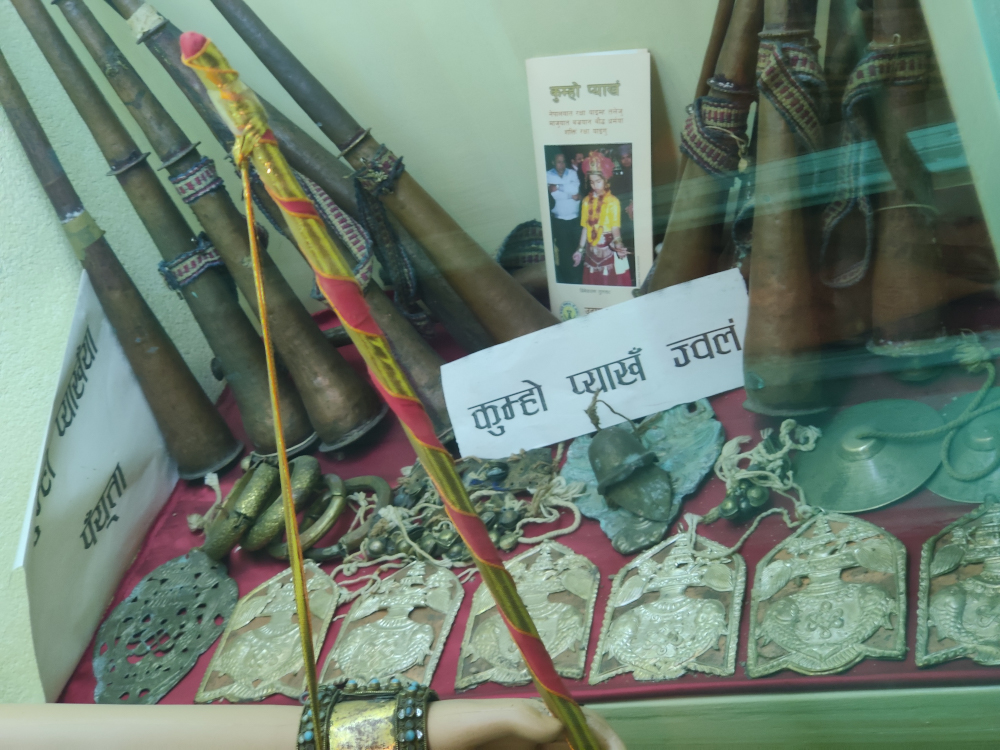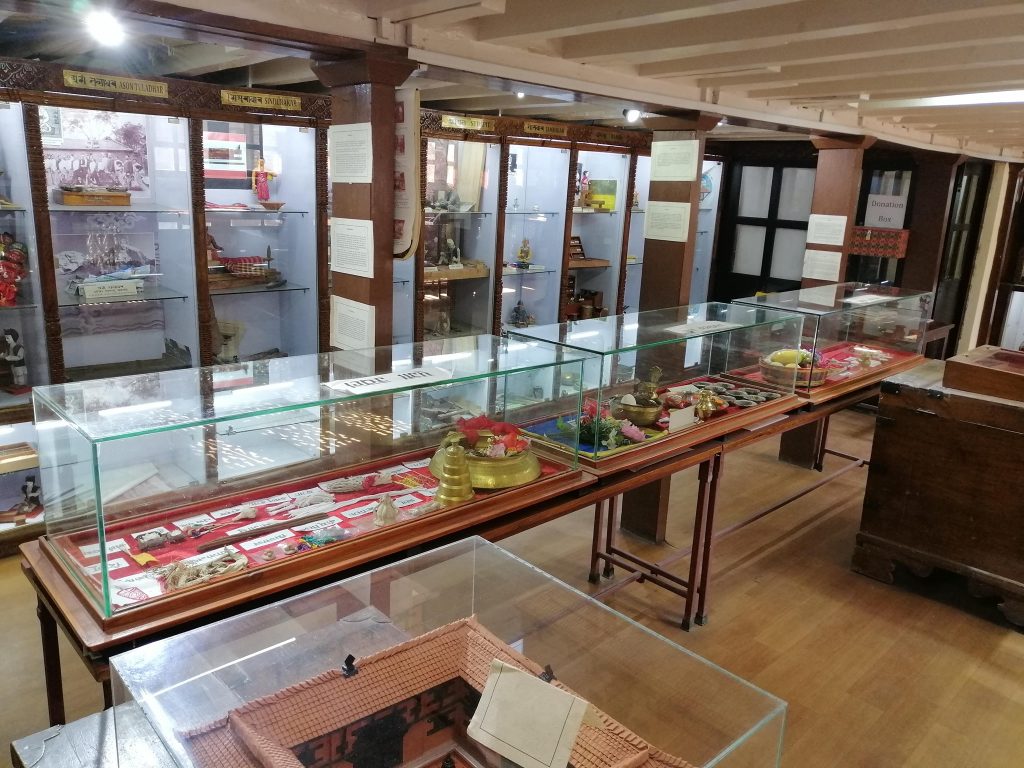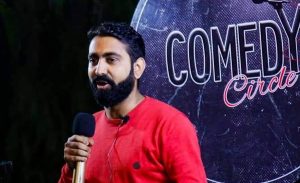If you are in Kathmandu and shop locally, one of the most famous places to go is Ason. Thousands of shoppers and passersby meet on the roads of Ason. Amid this chaos, a museum quietly awaits the visitors and recognition. The museum goes unnoticed by almost everyone.
It is an ethnic museum named Udaaya Museum managed by Udaaya Samaj, a group of nine sub-castes of the Newa community. It features the historic and cultural elements that represent these nine groups, namely Tuladhar, Kansakar, Tamrakar, Sthapit, Baniya, Shikrakar, Shilaakar, Silalik and Sindurakar.
But, sadly despite its rich collection, the museum fails to come into notice of not just the passersby but many young people residing in Ason itself. Either they are unaware that there is a museum or are unwilling to visit it.
Reasons for rare recognition
The nine sub-castes that the Udaaya Museum represents are said to be the native residents of the core Ason area. However, according to museum officials, even their presence in the museum is nil.
Alisha Manandhar, a resident of Ason whose family runs a shop just 50 metres away, says she was unaware of it. When she found out there is a museum there, it left her baffled but accepts she never made efforts to visit the museum.
Prafulla Tamrakar, another native of Ason, also attests to the problem, adding, “It is not just the younger generation. But it is equally hard to get the older generation to visit the museum.”
Museum Coordinator Suman Kamal Tuladhar who has been instrumental to bring the museum into life has observed the first problem people complain about is the space. “When they are in the museum, everyone is full of praises that at least someone is preserving this century-old heritage and customs. But, they all voice the same thing that they have problems parking their cars, and the museum should be relocated or have a bigger space.” This saddens Tuladhar to a great deal that the Museum is not getting its due recognition.

Tamrakar, a former teacher, adds that the interest in visiting museums has dipped to a worrisome level in all age groups. “Older generation that understands the culture does not have the interest as they think they already know the items, so why waste the time to see them.”
But she adds, “There are a few senior citizens who want to visit the museum, but since they are old and cannot walk much, we need to take them via vehicles. Climbing a narrow staircase is not that convenient either. So, if the museum had a rather open space, of course, it would have been easier for them.”
Tuladhar, however, says she does not want the Udaaya Museum to relocate. Rather says the place is an asset to the museum. “We are giving a natural, living experience of ethnic communities residing in Ason, in Ason itself. We want people to recognise this.”
Another problem is that people do not have a museum-going culture anymore. “The younger generation does not have an interest in cultural matters. They seek answers, but even their parents and grandparents now do not have the answers, resulting in their discontinued interest in anything.”
But, interestingly, they show interest when they are far physically. Tuladhar says, “About 20 per cent of the families have their young children going abroad. They crave knowing their roots, an identity, and the younger generation abroad show interest to learn about the museum and rich culture.”
The struggle
Though opened with the intention to preserve and educate people over time, the Udaaya Museum had to suffer the wrath of time. “The museum is in an old house. So when the earthquake struck Nepal in 2015, it suffered much damage. All items were scattered, the showcases and glasses were shattered. The house we are in also had to be supported by poles. And, this all meant we had to shut the museum for a long time,” Tuladhar explains.
“To bounce back, we collected money and renovated everything. For people to take notice of the museum, we even organised many events, talk programmes, and collaborated with organisations for exhibitions, in and outside the museum premises,” she informs, “We also collaborated with a few of the schools for occasional museum visits of the younger students. The reception was going good, people were talking about it, they were participating. And then Covid-19 struck Nepal.” She complains it has been difficult for the museum to recover since.
“As everyone is still struggling, there are no more physical events and fewer museum visits. Nonetheless, we did organise occasional online events and interschool drawing competitions (Covid and Me) in collaboration with the Museum of Childhood Ireland. Despite that, however, the museum is struggling both financially and socially.”
Tuladhar further says, “We started taking Rs 25 per visit from individuals and put up a donation box. But, the money is not enough. It is enough to give salary to the caretaker we have hired or a few maintenance works. Now, after Covid-19, the museum only opens two days a week. So that is also not enough to welcome more visitors.”
Need for preservation
The Udaaya Museum informally started in 2013, when the women of the Udaaya Samaj came forward and contributed to bringing it to life. It was inaugurated by cultural expert and scholar Satya Mohan Joshi, in 2014, says Tuladhar.
Stating that people who do not know their culture or language are lost, Tuladhar affirms that a lot of people here are lost and she was one of them.
“While working for UNICEF, I was abroad a few times,” she shares, “There, people used to ask me about a wide spectrum of Newa culture and heritage. While they used to praise our culture, I felt that I did not have a satisfactory answer or reference to give them.”
“For this reason, when I came back, I proposed the need for cultural documentation and worked with the Udaaya Misaa Pucha (the women’s group of the nine said sub-castes)” she explains, adding that now she has the missing answer.

“Udaaya Samaj Chairperson Roop Jyoti Kansakar sponsored the making of the museum, and members and neighbours contributed many historic and cultural items we exhibit today.” This includes traditional household items used in kitchens and for weaving, collection of coins and notes, visual representation of items used in cultural events, and contributions made by notable members of the collective community. Among them is a special collection explaining the type of professional works done by each sub-caste of their group.
“Within the Newa community, if you are to look at the cultural and social events, you will find that over 90 per cent of the work or involvement is from the Jyapus and Udaaya Samaj. Either it is about making the structures, or about food, clothes or music, the Udaaya Samaj is instrumental everywhere,” Tuladhar says, However, she expresses it is sad that there are not enough museums in Nepal. The other such museum is Jyapu Museum.
As the Udaaya Museum has well-preserved the historical and cultural elements of the udaaya samaj, Curator and coordinator Tuladhar says it is like an answer book to all culture-related questions one might have. Because of this reason, she says, though locals are ignoring the museum, it gets regular visits from those studying culture, worldwide, and stands tall as a reference to the rich culture.
But, Tuladhar says the museum now wants to make amends on the very fact the Udaaya Museum gets lost in the midst of chaos in Ason. “We have been planning to change the signboard for a long time now. Once the board is more visible, we expect the museum-goers will increase too. And they get to experience the culture that museum stands for.”


























